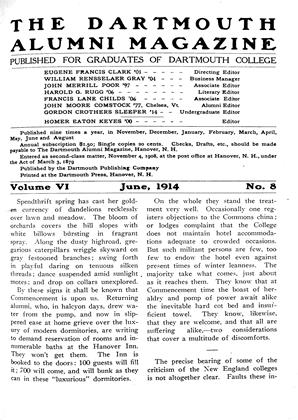Director General of the Pan-American Union. 8 vo. pp. 120. 61 half-tone prints. 12 maps and diagrams Pan-American Union, Washington, D. C.
The author of this very attractive and interesting volume is a Dartmouth man of "1889," widely known, as an explorer, publicist, diplomat, and now the efficient and enthusiastic Director of the Union, which aims to bring all the nations of the Western Hemisphere into closer accord.
It will be difficult to find elsewhere between two book covers such a surprising amount of information, explanation, and pictorial demonstration, making everything plain to the delighted reader's understanding. It answers a hundred and one questions which are asked, not only by tourists and prospective tourists, but also by the stay-at-homes.
A year ago it was very serviceable to the reviewer in giving him the sense of being somewhat at home on first arrival, so that there was no need to ask questions at every turn.
The folding map at the end, clearly printed in colors, is accurate and very convenient for the constant use of a visitor; while it impresses any intelligent reader with a vivid idea of the topography and "lay-out" of the Canal Zone and Canal works.
And one who thus gains a correct understanding of this stupendous achievement will not be misled by the popular or newspaper statement that the Canal "unites the two oceans." It does nothing of the sort. The passage is barred by dams and locks at both ends. The locks, operated by fresh water from Gatun Lake (the immense storage reservoir of 164 square miles area) lift the vessels 85 feet above sea level. After a trip of 32 miles in fresh water, at this level, other locks gently drop them to ocean level again. This lake which serves both as a barrier and means of passage, was the only solution of the problem. It is now proved that a sea-level canal was impracticable.
 View Full Issue
View Full Issue
More From This Issue
-
 Article
ArticleTHE SPREAD OF ENGLISH
June 1914 By LeRoy Robinson Sawyer -
 Article
ArticleOUR COLLEGE DEBT
June 1914 By Lewis Parkhurst '78 -
 Article
ArticleSpendthrift spring has cast her golden
June 1914 -
 Class Notes
Class NotesLOCAL ASSOCIATIONS
June 1914 -
 Article
ArticleTHE AMERICAN JAPANESE PROBLEM
June 1914 By Sidney L. Gulick, C. H. H. -
 Article
ArticleROBINSON HALL
June 1914
John Barrett
Article
-
 Article
ArticleTHE CONFERRING OF DEGREES
June, 1909 -
 Article
ArticleREPORT OF THE ALUMNI FUND—APRIL 20, 1931
MAY 1931 -
 Article
ArticlePresident to Meet Western Alumni
October 1946 -
 Article
Article"WE ARE PROUD TO GIVE YOU THE DARTMOUTH ALUMNI AWARD."
November 1976 -
 Article
ArticleThe Undergraduate Chair
January 1948 By JOHN P. STEARNS '49. -
 Article
ArticleCongress To Act?
Mar/Apr 2008 By Lee Michaelides



